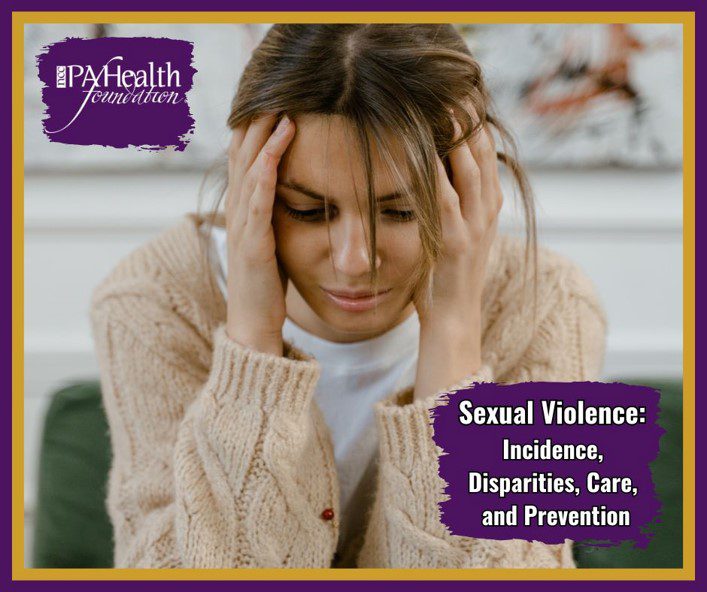Sexual Violence: Incidence, Disparities, Care, and Prevention
Despite the “#MeToo” movement that aimed to bring awareness to sexual harassment and assault, to end sexual violence, and to hold perpetrators accountable, the numbers of individuals experiencing these physical and mental traumas are still staggering.
Sexual violence is any sexual activity that occurs without consent and can occur in person or through the use of technology, such as posting and/or sharing pictures of a sexual nature. More than 50% of all women and 33% of men have been the victims of sexual violence that involved physical contact in their lifetime. Twenty-five percent of women and 1 in 26 men experienced an attempted or completed rape. Of those, 33% of women and 25% of men were between the ages of 11 and 17 years. More than half of the women who reported a rape noted it was by an intimate partner and nearly 41% noted the perpetrator to be an acquaintance. In addition, nearly 25% of undergraduate women were found to have been the victims of sexual assault or misconduct in a study conducted at 33 of the United States’ major universities.
Disparities exist regarding sexual violence for racial, ethnic and sexual minority groups. The incidence of rape or attempted rape is higher in multiracial women, American Indian/Alaska Native women, and Black women, compared to non-Hispanic white women. The same pattern of disparities is seen among men who experience sexual violence. Among sexual minorities, bisexual and lesbian women and bisexual and gay men have significantly higher rates of an experienced rape at some point in their lives compared to heterosexual men and women.
Unfortunately, only about a quarter of those who experience sexual violence report these crimes to the police. Underreporting can occur due to fear of retribution or from shame and embarrassment.
As PAs, we need to be vigilant in observing, questioning, and intervening when we suspect sexual violence has occurred. As providers, we need to ask if our patients feel safe in their home, school, and work environments. We need to ask about the development of risky behaviors such as the use or abuse of alcohol and drugs or risky sexual behavior. On physical exam, we need to pursue signs of physical assault such as bruising, genital injuries, and sexually transmitted infections. We need to monitor patients we know to be victims of sexual violence for PTSD, depression, anxiety, and suicidality and be ready to provide appropriate care.
While providers can address sexual violence after it has occurred, we must also work in partnership with our communities to prevent sexual violence. Prevention requires that we understand and work to change risk factors that lead to sexual violence. The CDC has developed prevention strategies to decrease sexual violence, which include:
- Promoting social norms that protect against violence.
- Teaching skills to prevent sexual violence.
- Providing opportunities to empower and support girls and women.
- Creating protective environments.
- Supporting victims/survivors to lessen harms.
Sexual violence is a public health issue with a significant economic cost burden that affects not only the individual victim but society as a whole. As PAs, we must employ primary preventive measures to educate individuals and communities on strategies to decrease sexual violence in our country.

For information and resources, visit the following websites:
- Preventing Sexual Violence: Centers for Disease Control and Prevention: https://www.cdc.gov/sexual-violence/prevention/index.html
- National Sexual Violence Resource Center: https://www.nsvrc.org/
- RAINN: National Sexual Assault Hotline: Confidential 24/7 Support: Online or at 800.656.HOPE (4673)
References
- Centers for Disease Control. (2024) Sexual Violence Prevention. https://www.cdc.gov/sexual-violence/about/
- Smith, S. G., Zhang, X., Basile, K. C., Merrick, M. T., Wang, J., Kresnow, M., & Chen, J. (2018).The National Intimate Partner and Sexual Violence Survey: 2015 data brief – updated release. Centers for Disease Control and Prevention.
- Black, M.C., Basile, K.C., Breiding, M.J., Smith, S.G., Walters, M.L., Merrick, M.T., Chen, J., & Stevens, M.R. (2011). The National Intimate Partner and Sexual Violence Survey (NISVS): 2010 Summary Report. Atlanta, GA: National Center for Injury Prevention and Control, Centers for Disease Control and Prevention.
- Cantor, D., Fisher, B., Chibnall, S., Harps, S., Townsend, R., Thomas, G., Lee, H., Kranz, V., Herbison, R., & Madden, K. (2019). Report on the AAU Climate Survey on Sexual Assault and Sexual Misconduct.Association of American Universities.
- Breiding, M. J., Smith, S. G., Basile, K. C., Walters, M. L., Chen, J., & Merrick, M. T. (2014). Prevalence and characteristics of sexual violence, stalking, and intimate partner violence victimization–National Intimate Partner and Sexual Violence Survey, United States, 2011. MMWR Surveillance Summaries, 63(8), 1-18.
- Walters, M. L., Chen J., & Breiding, M. J. (2013). The National Intimate Partner and Sexual Violence Survey (NISVS): 2010 Findings on Victimization by Sexual Orientation. Atlanta, GA: National Center for Injury Prevention and Control, Centers for Disease Control and Prevention.
- Morgan, R., & Oudekerk, B. (2019). Criminal victimization, 2018 (NCJ 253043). U.S. Department of Justice, Bureau of Justice Statistics.
- Basile, K.C., DeGue, S., Jones, K., Freire, K., Dills, J., Smith, S.G., Raiford, J.L. (2016). Sexual Violence Prevention Resource for Action: A Compilation of the Best Available Evidence. Atlanta, GA: National Center for Injury Prevention and Control, Centers for Disease Control and Prevention.
- National Sexual Violence Resource Center. https://www.nsvrc.org/

